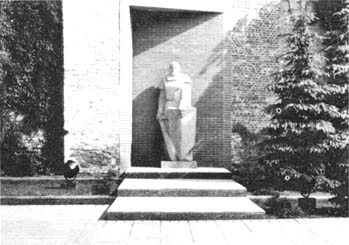Editor of this issue: Violeta Kelertas
Copyright © 1988 LITUANUS Foundation, Inc.

|
LITUANUS
LITHUANIAN QUARTERLY JOURNAL OF ARTS AND SCIENCES
Volume 34, No. 1 - Spring 1988
Editor of this issue: Violeta Kelertas ISSN 0024-5089
Copyright © 1988 LITUANUS Foundation, Inc. |

|
HERKUS MANTAS IN KLAIPĖDA, LITHUANIA
Executed by the sculptor Vytautas Mačiuką, this statue of the Prussian rebel leader Herkus Mantas graces downtown Klaipėda today. Since being unveiled in 1987, the monument has become a favorite place for newlyweds and others to be photographed, thus attesting to the symbolic significance that this commander of the ancient Notangian tribe continues to have for the Lithuanian people.
Herkus Mantas, whose date of birth is unknown but who died in 1273, spent his life fighting encroachment of the Teutonic Order on Prussian territory and was captured and hanged toward the end of the unsuccessful insurrection, which lasted from 1260 to 1274. However, he led the Prussians in several victories over the Teutonic knights, whose forces were strengthened by Christian supporters from Western Europe. For a while it appeared that the Prussian tribes would be able to defend themselves and their pagan way of life from the invaders; nevertheless, because of infighting among the tribes themselves and ineffectual help from the Grand Duchy of Lithuania, which was beset by its own political problems after the murder of Mindaugas in 1263, the Prussian cause was lost, the people were either bloodily massacred or lost their identity in brutally enforced union with the invaders, the Prussian language became extinct.

Statue of Herkus Mantas in Klaipėda, Lithuania.
The ancient Prussians have always held a fascination for the Lithuanians and served as a warning. Herkus Mantas, immortalized in this monumental statue, is a reminder of the price of survival.
The ancient Prussians have always held a fascination for the Lithuanians and served as a warning. Herkus Mantas, immortalized in this monumental statue, is a reminder of the price of survival.
The statue stands four meters tall in a niche of six meters, built into a wall of red brick. The three granite steps, leading up to the figure of Mantas, symbolize the three rebellions that he led against the Order.
Vytautas Mačiuką (born 1930) is both a poet and a sculptor and one of only two Lithuanians who belong to both the Artists' Union and the Writers' Union. He has completed many monuments and sculptures that can be found all over Lithuania and which stand out for their economy of means, yet are powerfully suggestive.